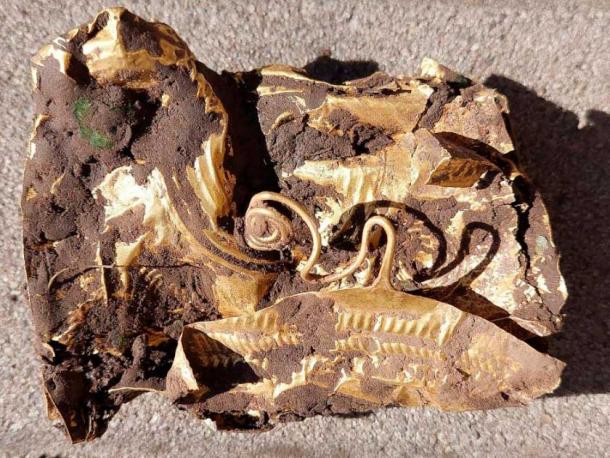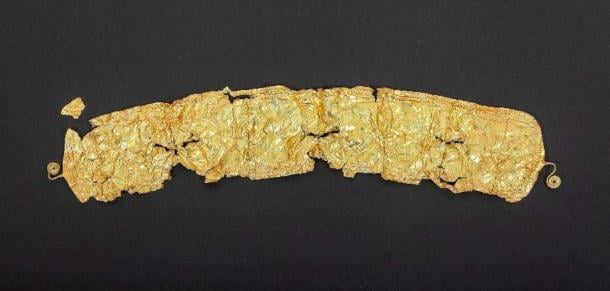“Supernatural” Bronze Age Gold Device Unearthed in Czech Republic

“Supernatural” Bronze Age Gold Device Unearthed in Czech Republic
Last month a beet farmer in the Czech Republic uprooted an ornate Bronze Age gold artefact. It was well preserved in mud and the anonymous farmer photographed the golden treasure and then sent the images to archaeologists at the Silesian Regional Museum in Opava, a city in the Moravian-Silesian Region.
The wafer-thin and crumpled sheet of gold is estimated to have been created around 2,500 years ago.

Crafted with Supernatural Concepts in Mind
Dr. Jiří Juchelka is an Opava archaeologist who leads the archaeological sub-collection of the Silesian Regional Museum. The researcher told Radio Prague International (RPI) that the golden piece measures “51 centimetres (20 inches) long” and was found in a “near perfect condition” with silver, copper, and iron inclusions. The museologist said, “it’s decorated with raised concentric circles and topped with rose-shaped clasps at the end.”
According to Live Science, museum conservator Tereza Alex Kilner said that while nobody can be sure, the golden artefact was most likely “the front of a leather belt.” But this is no ordinary belt fastener either because the archaeologists believe it was constructed with cosmological/supernatural concepts in mind.
3,500 Years Old and Still Shining
Dr. Kilnar is currently preserving and analyzing the belt fastener at the Museum Bruntál . According to the museum website, this is a contributory organization of the Moravian-Silesian Region that administers important cultural heritage sites in northern Moravia – Bruntál Chateau, Sovinec Castle, and the Scythe Maker’s House in Karlovice in Silesia.
Without having tested the gold, and based only on the artistic style, Kilnar suspects the gold belt buckle dates to around the middle to late Bronze Age, which means the piece was worn around the 14th century BC. At this time small communities of farmers inhabited timber-frame houses and hadn’t yet begun forming the larger agricultural settlements which occurred in the following centuries.

Putting a Face to a Discovery
Earlier this year a team of Czech archaeologists published the image of a Bronze Age woman which was reconstructed after DNA analysis. The woman was unearthed from an ‘elite grave’ in Mikulovice, in Eastern Bohemia. According to a report in Expat.cz, she had “fair skin, brown hair, widely spaced brown eyes, a prominent chin, a petite figure,” and she died at around 35-years-old.
Described as having “one of the richest [Bronze Age burials] ever discovered in Europe,” the woman was from the Únětice culture, and she was found wearing bronze and gold jewellery, including a rare amber necklace. This group of early agriculturalists lived in Central Europe from about 2300 to 1600 BC, and they were contemporary with the culture that crafted the Bronze Age gold belt fastener.
Elite Connections with the Otherworld
It cannot be determined exactly which group made the gold buckle, for at that time ( 2000 B.C. to 1200 BC ) Central Europe was a rich fusion of different cultures. Smaller communities began coming together and formed a trade network by which livestock and crops such as wheat and barley were exchanged.
This period saw new social divisions emerging. Those people who controlled the lands around the emerging trading centres represented the origins of societal elites. At that time silver and gold became hallmarks of the controlling economic class and Kilnar told RPI that the gold item probably belonged to someone in “a high position in society because items of such value were rarely produced at the time.”
Professor Catherine Frieman at the Australian National University is a specialist in European Bronze Age metalworking. She agreed, and told RPI that the owner of the gold belt buckle “was someone of high status, either social or spiritual.”

Crafting Cosmology in Bronze Age Gold
Live Science reports that during the Bronze Age gold objects, and gold hoards, were generally buried “in special, isolated locations suggesting a kind of gift exchange between the cultural elite and the supernatural.” Frieman told LiveScience in an email that gold objects with circular motifs are often linked to “Bronze Age cosmological systems believed to focus on solar cycles.”
In 2013, Dr. Joachim Goldhahn at The University of Western Australia published a paper called “rethinking cosmology in the Bronze Age using a north European perspective.” This researcher determined that the cosmologies of the Bronze Age world were based on “pragmatic ritualised practices, which were continuously repeated and recreated at certain times and occasions.”
Thus, the gold belt fastener most probably represents the annual cycle of the sun. But more so it might have been a centrepiece in a repeated ritual, and worn at specific “times and occasions” in the year, for example, perhaps to symbolically mark key stages of the sun’s cycle, like the equinoxes and solstices.